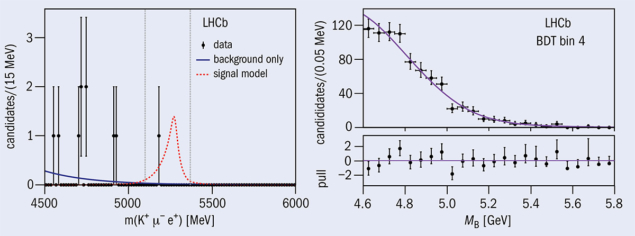A report from the LHCb experiment

Processes where the flavour of charged leptons is not conserved are undetectably rare in the Standard Model (SM). For neutral leptons, flavour violation is known to occur in neutrino oscillations, but charged-lepton-flavour violation (CLFV) is so suppressed that, if observed, it would provide indisputable evidence of physics beyond the SM.
The LHCb collaboration recently reported the results of searches for two CLFV decays, B+ → K+ μ± e∓ and B(s)0 → τ± μ∓, using 3 fb–1 of data collected in 2011 and 2012. The two decays provide complementary information as their final states involve charged leptons from different families, and both represent experimental challenges for LHCb. While the detector performance is excellent for muons, it is more difficult to reconstruct electrons and taus. The difficulty with electrons is related to energy losses via bremsstrahlung radiation. Meanwhile, the short-lived tau leptons are always reconstructed from their decay products, which include at least one neutrino, and thus part of the tau’s energy is unavoidably lost. In both cases, the analyses are able to recover some of the lost information and improve the resolution by exploiting constraints on the kinematics and topology of the decay.
Neither search found a signal (figure 1), but thanks to these reconstruction techniques and the large quantity of B-meson decays recorded by the detector, LHCb has established the most stringent upper limits on the branching fractions of these decays: 9.5 × 10–9 for B+ → K+ μ− e+, 8.8 × 10–9 for B+ → K+ μ+ e–, 1.4 × 10–5 for B0 → τ± μ∓, and 4.2 × 10–5 for Bs0 → τ± μ∓ (all at the 95% confidence level). The latter is also the first ever limit on Bs0 → τ± μ∓.
Decays of B-mesons are particularly interesting in light of recent flavour anomalies
CLFV decays of B-mesons are particularly interesting in light of recent flavour anomalies, whereby LHCb found hints that the decay rates for b → sμ+μ– and b → se+e– are not equal (CERN Courier May/June 2019 p33). While the anomalies are most suggestive of the violation of lepton flavour universality, several proposed extensions to the SM that address them also predict CLFV, with branching ratios for B+ → K+ μ± e∓ and B(s)0 → τ± μ∓, which are within LHCb’s reach. The latest LHCb results therefore impose strong new constraints on beyond-SM models. The analyses also open the door to further LHCb tests of CLFV by demonstrating the feasibility of searches for rare processes with final-state electrons and taus.
Further reading
LHCb Collaboration LHCb-PAPER-2019-016.
LHCb Collaboration LHCb-PAPER-2019-022.








